CTP Episode of the Day - 09.20.06 - Fight the Future
Today's Cherished Movie: Fight the Future
Original Release Date: June 19, 1998
Story By: Chris Carter & Frank Spotnitz
Screenplay By: Chris Carter
Directed By: Rob Bowman
North Texas: After falling through a hole in the ground, a young boy is infected by the alien Black Oil. One week later, in Dallas, a federal building is bombed by terrorists, killing five people, including the boy. Mulder and Scully, now part of an FBI anti-terrorism unit, learn that the boy as well as three other victims were dead even before the bombing. Cause of death: an alien virus. In the Texas desert, the agents find an agricultural complex that may hold the key to unlocking the government conspiracy surrounding the extraterrestrials and their lethal virus.
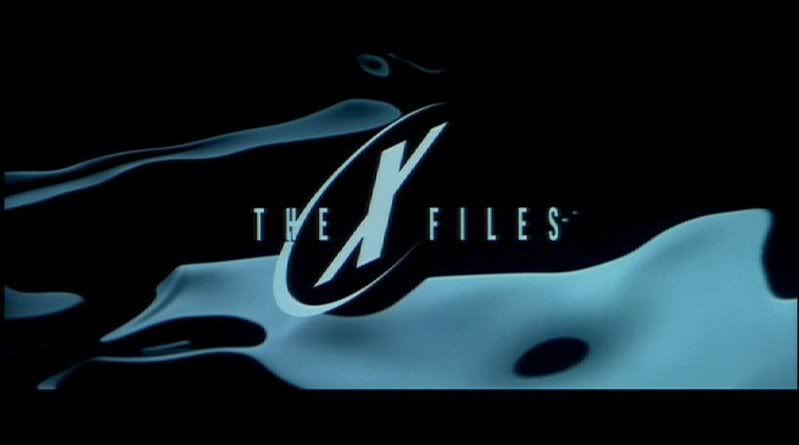
"I'm the key figure in an on-going government charade, the plot to conceal the truth about the existence of extraterrestrials. It's a global conspiracy, actually, with key players in the highest levels of power, that reaches down into the lives of every man, woman, and child on this planet. So, of course, no one believes me. I'm an annoyance to my superiors, a joke to my peers. They call me Spooky. Spooky Mulder, whose sister was abducted by aliens when he was just a kid and who now chases after little green men with a badge and a gun, shouting to the heavens or to anyone who will listen that the fix is in, that the sky is falling and when it hits it's gonna be the s---storm of all time."
Some "Fight the Future" Tidbits & Musings:
-- "We had been cruising along with the show and it got more and more successful through the years," said XF creator Chris Carter. "We'd always said that we were making a little movie each week. That was really the spirit in which the show was done on an episodic basis. And so I think it was a natural extension of that for the idea to pop up, 'Why don't we do a movie?' It had been something we tossed around, but we realized at the end of five years would be great to do a big event, something that would celebrate and reward the hard-core viewers who had been watching the show since the beginning. The trick was to do a movie that wasn't just for X-Files fans but that would appeal to the casual viewer or the non-watcher of X-Files."
-- "We only wanted to go to the big screen if we could somehow deliver something bigger and more dynamic than we could do on the little screen," said producer Daniel Sackheim. "And the movie allows you to tell bigger stories on a bigger canvas and to do some very exciting visual storytelling."
-- Chris Carter and Frank Spotnitz spent their 1996 Christmas vacation in Hawaii. During that vacation they agreed that in order to make a movie, they would have to come up with an idea bigger than the series. "A concept that could be worthy of a movie and explain some things that didn't or hadn't been explained," said Chris Carter. "So we needed this big idea that needed to be started in an extreme place and needed to end in an extreme place. We did some research and found out that the globe had been covered in ice, not that long ago in historical terms, as far down as Texas. So we thought wouldn't it be interesting to take someplace we wanted to shoot which is the desert and make it a completely different landscape prehistorically, and also it was an idea that encompassed the bigger idea here which was that alien life has been here on earth."
-- During that Christmas vacation, Carter and Spotnitz came up with the story for the film. They worked out the basics and laid the plot out very carefully. In February 1997, while filming of the fourth season of The X-Files and the first season of Millennium continued, Carter snuck away for ten days and wrote two-thirds of the movie. "I still don't know how I did it," Carter said. "It was enough to give the studio, to show them what we wanted to do." Twentieth Century Fox green lighted the project as a result of that two-thirds of the script -- approximately 90 pages. "We started to prep the movie over the course of the next several months," Carter explained, "That being March, April, and May, with the movie scheduled to start shooting in June. It was a short prep, it was costly. It was all done as the 'thing' we were doing in addition to the television series. I wouldn't ever do it that way again, but it did have a certain amount of benefits because we all knew the TV series so well, we all knew the things that work."

-- "The conspiracy is what originally fueled the show," Chris Carter said, "and was the sort of core idea which drove the series -- the conspiracy of the government to keep the truth about the existence of extraterrestrials from the public. And that is the story we've gone back to. It has now become the movie and we answer a lot of questions about that. And as any hard core fan knows, there are a lot more to answer."
-- But what about the rest of the ticket-buying public? "We were determined that the movie would be entertaining and make sense to people who had never seen the X-Files before and that was sort of the litmus test for every scene, every idea," said co-writer Frank Spotniz. "It had to make sense if you were coming to it fresh. But at the same time, we wanted to reward the fans. We felt like they'd be expecting and deserved to see some answers to some of the mysteries that had been raised in the series over the past five years."
-- Many thought Carter would want to direct the film himself, but instead the job was put in the capable hands of first-time film director Rob Bowman, a veteran television director including (at that time) more than 25 episodes of the series. According to Bowman, Chris Carter called him after seeing Bowman's final cut of the Season 3 episode "731" and asked him to direct the X-Files movie.
-- "I wanted to exploit the visual tapestry that I thought Chris and I were capable of, and he wrote this script knowing that I was going to direct it," said Bowman. "He wrote it right to my strengths. I think the show had always promised that it could, if given the opportunity, be huge, and look well on a movie screen. I wanted to make sure I fulfilled that promise and then some, so it was about me educating my eye where to place things in a horizontal frame specifically for the XF movie. We'd explored this mythology in so many different ways that it was time to get to some answers. And you know we have proven and disproven theories and conspiracies and guilty parties so many times that eventually we've got to show who's up to what and why they're doing it. And give the viewers and the new fans a great mystery, with some sensational images, a Chris Carter script, and a Mark Snow score, and do it all the best we've ever done it with five years of practice and it seems to me it's basically coup de gras of all our work to date."
-- David Duchovny was glad that Bowman was chosen to helm the project. "We have a shorthand. He understands the way Gillian and I work, and we understand the way he works. So there's a lot less anxiety about the newness of [making the film] by working with him. He understands the show and the characters, so we're in recognized territory! Rob also has a great flair for playing with big toys and with everything necessary to turn a piece of television into a real movie."
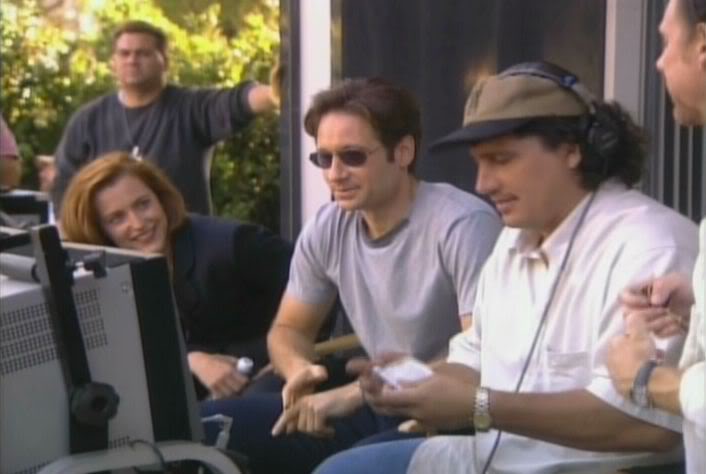
-- Four years after the start of the series, filming began on the X-Files movie in June 1997. Filming was scheduled to be completed during the hiatus between the show's fourth and fifth seasons. "We didnít have to create something completely from scratch so that was helpful," said Chris Carter. "But no one was used to working on that pace and when you work weekends, you spend more money, and the budget goes up for things that donít ever show up on screen just because you're pushing the limits of time because we needed to get this movie made in the course and span of the time between seasons four and five. Before the movie was even finished filming we were back into our process again of coming up with stories and writing scripts and going right back into Season 5 of the television series. So, it really was done on our vacation time. We ended up working for two years straight, all of us. That is probably not the best way to work, but itís the only way we could do this movie which we were all determined to do."
-- To ensure the story remained a surprise for those sneaky X-Philes who week-in and week-out were somehow able to get the juicy details about each episode of the television series, a certain amount of secrecy was necessary. The script was printed on red paper so it couldn't be xeroxed, and disinformation was leaked all year long to throw fans off the scent. The ending wasn't written until a few weeks before it was filmed.
-- In another attempt to outsmart the fans, the movie was filmed under the code name of "Blackwood." Though not directly mentioned in the movie, Blackwood was the name of the Texas town where Stevie and the firemen were infected by the black oil -- you could see Blackwood Fire Department on the fire trucks that came to rescue Stevie.

-- Carter might have chosen the name "Blackwood" as a reference to an "interesting" magazine that was published in the 1800's called "Blackwood's Magazine," or "Blackwood's Edinburgh Magazine." It was known for printing horror and other outrageous stories, most of which were written as if they were true. Edgar Allen Poe wrote a few short stories referencing this magazine, one called "How to Write a Blackwood Article" and "Loss of Breath -- A Tale Neither In Nor Out of 'Blackwood'." He also listed the fictitious author of this story as Mr. Blackwood Blackwood.
-- "Blackwood" is also a term used in bridge. It is a method used to find out how many aces or kings your opponent has.
-- Stevie is named after one of Carter's boyhood friends. Carter says that he and the real Stevie used to dig holes a lot, just like in the movie.
-- Stevie was played by Lucas Black. "We first saw him in Slingblade," said Rob Bowman, "and he just sort of has a very natural, easy going pace about his delivery. We thought it would bring the audience closer into the storytelling because he sounds like the everyday boy from next door. The other boys, I think, were all found in Virginia and North Carolina and what not. We were looking for as natural a delivery as we could find." Only one of the boys who played Stevie's friends had any acting experience.
-- "Our mantra on the TV series has always been: 'Itís only as scary as it is believable and itís only believable if it feels real,' which is what I think science fiction should always attempt to do," explained Chris Carter. "So because we needed to recreate Dallas, we went and scouted in Dallas and Texas and found out that it would be prohibitively expensive and that we need to shoot the bomb sequence in Los Angeles." To disguise the familiar Los Angeles skyline, the location managers had to find just the right rooftop and appropriate camera angles had to be applied. Then Mat Beck, visual effects producer, came in and helped to take away a little bit of the background in postproduction.

-- The scene on the rooftop was a nice introduction to the characters of Mulder and Scully without boring the hard core fans. "This is the introduction of not just one character but two, as well as the introduction of the characters as a pair," said Chris Carter. "As fans of the show know, Mulder and Scully have not just a respect for one another, and an affection, and a protectiveness but they have a deep love for one another. Where this goes in the movie, is a place it has never gone before in the television series and it ends up in a pivotal scene in Mulderís hallway. That needed to be set up here in the beginning of the picture. We needed to make sure we didnít go too far ultimately with these characters to too far a place cause we needed to come back to this place for the next year of the TV series, which would be year six. So there again, filmmakers usually donít have to think conservatively, but we needed to make sure the relationship was understood, intact, went somewhere new, yet didnít go so far as to be irreparable."
-- How appropriate, and a nice nod to the veteran fans: The first line spoken by Scully on the big screen was "Mulder, it's me." Mulder reciprocates with a "Scully, it's me" when he calls her while she's hiding at Bethesda Naval Hospital. It's also quite appropriate that the new viewers meet Mulder and Scully as they are talking on their cell phones -- certainly a trademark of the series. In fact, Chris Carter once said, "I don't think I could have done a TV show like this pre-cell phones."
-- Early on in the script process, Rob Bowman was resistant to the idea of the federal building explosion, given the similarity to events in Oklahoma City. But in the end, he felt the fact that the two agents were able to clear the building before the explosion made the difference.
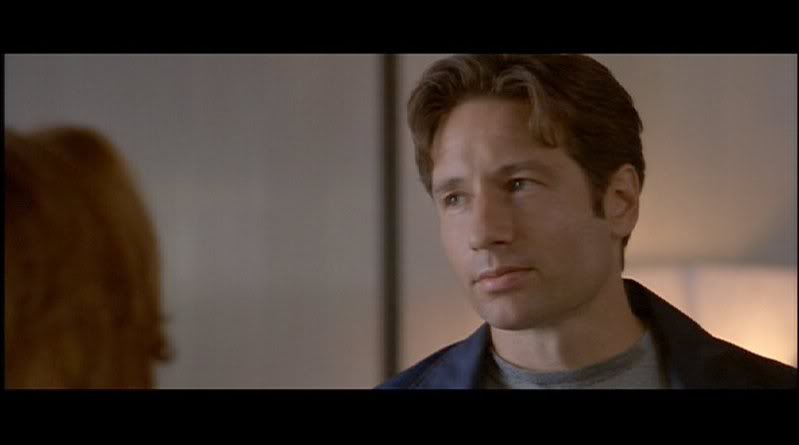
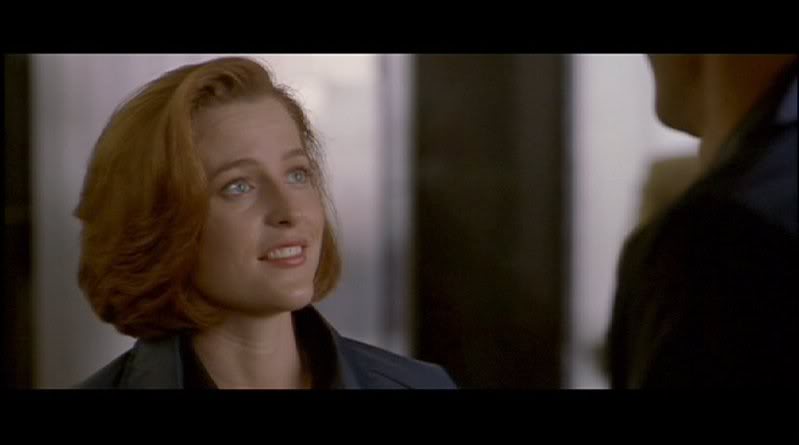
-- Former LAPD bomb squad officer Herb Williams and former FBI agent Will Heaton acted as advisors for the bomb sequence -- and appeared in the movie as agents in a scene with Scully.
-- 13:56 is the first countdown-time number that Mulder recites when he is trying to convince Scully that he is indeed locked in with a bomb. Chris Carter's birth date is October 13, 1956.
-- The building explosion was created by combining a real explosion with special effects including miniatures and computer-generated images. Bowman used 14 cameras to capture the action during the real explosion in order to have footage from every possible angle. In the final cut, Bowman chose to show the explosion through the point of view of the main characters, "that is by following them into the car, staying with them in the car, through the explosion and only using third-person or objective shots of the building to show the degree of damage or the size of the explosion. But nothing else, nothing gratuitous, not a lot of panic shots with the crowd, just Mulderís and Scullyís perception and experience of this explosion."
-- "I would have thought Rob Bowman would have been completely overboard with gadgets and stuff," said David Duchovny during filming. "But heís not. It's been surprising. Heís really kept us on the ball [focusing on] the story and the characters."
-- 619 is the number on the "Office of Professional Review" door (where Scully is interrogated by the Assistant Directors). (It's also the number on one of the domes in Antarctica.) 06/19 was the date that the movie opened.
-- When all of the bathrooms are occupied in Casey's Bar, Mulder finds relief outside in the alley -- under a poster for 1996's hit movie Independence Day. There's the obvious alien tie-in, but this is also a reciprocal joke, as the X-Files TV series was mentioned in the movie Independence Day.
-- "The movie was my chance to cast people that Iíve always admired in movies," said Chris Carter. "Character actors, wonderful character actors like Armin Mueller-Stall and Martin Landau. Luckily I had the good fortune of not just writing for them but being able to cast the people I actually wrote for in the roles that we created for them." Carter said he had a "secret desire" to see some of them in the series in the upcoming season, but noted it would be a "difficult trick" to get them to come and be a part of the series. An impossible trick, apparently, as it didn't happen.
-- Dr. Alvin Kurtzweil was supposedly based on a real person, a doctor who died under suspicious circumstances. Kurtzweil's beliefs were modeled after Milton William Cooper, a real-life conspiracy theorist who has written conspiracy books similar to those seen in Kurtzweil's apartment. One of Cooper's books is titled "The Secret Government," and he was the first to suggest that FEMA would take over the U.S. Government, saying such things as "it will happen on a holiday, when patriots are away from their homes." The phrase "silent weapons for quiet wars" also appears in his work. It is also worth noting that the name "COOPER" is on the back of the "fake" ambulance that Scully is loaded into.
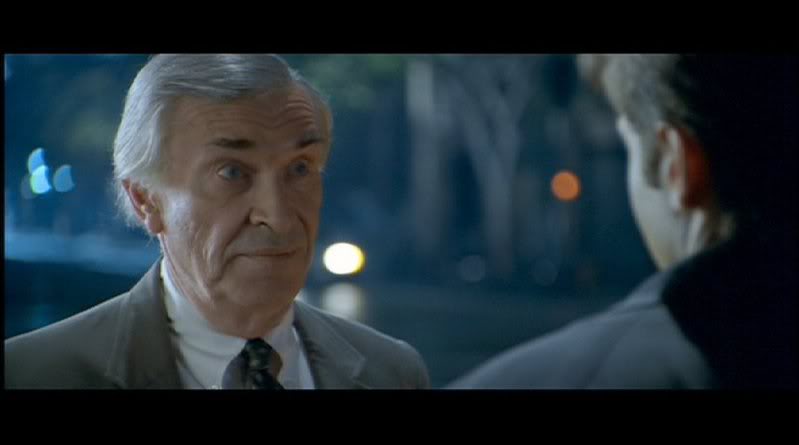
-- I always hoped that Mulder intended to make another pit stop when he asked the taxi driver to take him to Arlington, rather than accept the fact that TPTB forgot that Mulder lived in Alexandria.
-- The fact that Kurtzweil was a gynecologist was a reference that "only the die hard fans will get," said Bowman. Bowman explained that Kurtzweil was someone who was once a part of, and who is now on the outs with the syndicate and the conspiracy -- a conspiracy which included conducting fertility experiments on abducted women who then contracted cancer and died -- something a gynecologist might have been involved in.
-- The FBI Field Office in Dallas was actually a set built in a giant computer room in the Unical building in downtown Los Angeles. The set decorators put in dividing walls to get a look reminiscent of the film All the President's Men, when Dustin Hoffman and Robert Redford were in an office with florescent lights that go on forever.
-- 11:21 is the time Mulder goes to the Dallas Field Office where Scully joins him and analyzes the fossils; and 1121 is also a number on one of the domes in Antarctica. 11/21 is the birth date of Chris Carter's wife.
-- There are two great scenes that help demonstrate the bond between Mulder and Scully for the uninitiated viewer, but that can be greatly appreciated by the long-time fans. First, Scully uses her scientific background to examine the fossils at the Dallas Field Office and she needs only look at Mulder and he knows exactly what she's saying. Then the simple scene in the car as they are chasing the unmarked tanker trucks. Scully says go right, Mulder says go left, so they meet halfway and go forward where they find the answers. That pretty much sums up the partnership between these two characters.
-- Exterior shots of the Well-Manicured Man's residence in London were shot at a house in Pasadena that was used as the exterior location of Wayne Manor in the Batman television series.
-- Speaking of which, the X-Files was the second Twentieth Century Fox Television-produced series to transfer to the big screen. The first was Batman. However, the Batman movies were produced after the TV series ended, as have many other feature films that sprung from TV series. The X-Files was the first TV show to be made into a feature film while the TV show was still on the air.
-- Conrad Strughold was named for the real Strughold, a Nazi scientist who conducted experiments on prisoners during World War II. The U.S. government secretly brought Strughold over after the war to work on the space program. It is also worth mentioning that in Season 3's "Paper Clip," Mulder and Scully discover "lots and lots of files" at the Strughold Mining Company.
-- One of the differences between TV and the movies is that Mulder could actually expand on those expletives that he started in "Bad Blood" and "Triangle." There was a scene in the original cut of the film where Scully dropped the "F" bomb as she's chastising Mulder for dragging her through Nowhere, Texas, chasing tanker trucks; but the word was cut to help the film get a PG-13 rating. In the final cut, her words are cut off by the train crossing warning bell, but you get the idea.
-- Speaking of F-bombs, Rob Bowman noted that David Duchovny, used to the usual pace of the series, became impatient on the movie set. ďDavid would walk on to the set and say, ĎWhat the f--k is taking so long?í I said ĎIt's a movie, David. It takes longer to makeí," joked Bowman.
-- "The challenge of the bee sequence was that we were going to be working with 300,000 living, stinging bees," said Rob Bowman. "And how do we do that for days on end without everybody getting stung and mad? Gillian and David couldn't wear protection during those scenes, so initially some of us chose to stand up with our actors and not wear protective gear. But then Danny Sackheim got stung, our solidarity was done, and the protective gear came out for all the crew."
-- "The days that we shot that sequence, everything was about the bees," said Gillian Anderson. "Our clothes were glued to us along the wrists and collars. The bee doctor told us that you're not supposed to pat your clothes at all just in case there is a bee stuck in the folds. If you pat it, then the bee is likely to sting you out of trying to protect itself. When they were filming my close-up where I can't see and David comes back for me, the bee doctor was throwing hundreds of bees on top of me as I'm running, and I noticed at one point there were a whole bunch of bees around my wrist. So David comes in and he grabs me by the wrist to pull me along, and I'm thinking, 'There's bees under there!'"
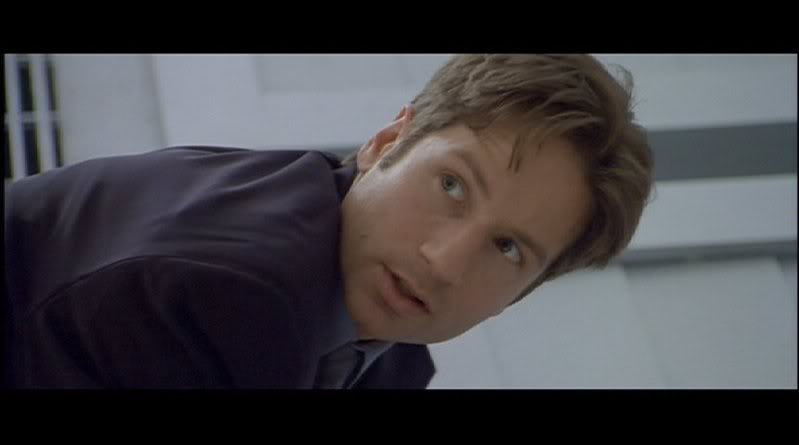
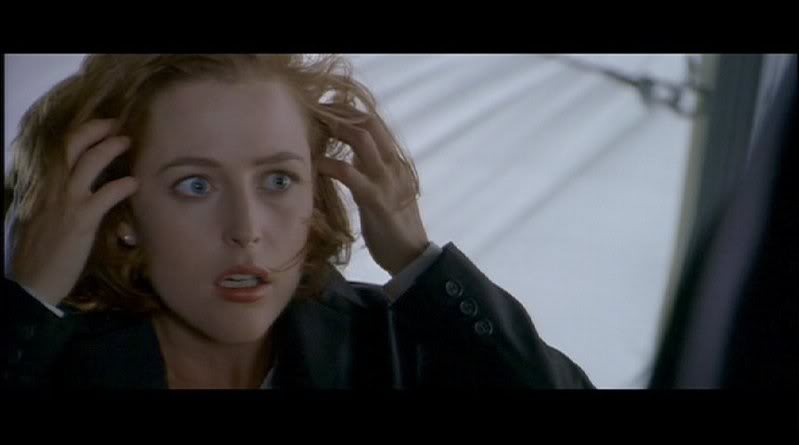
-- Even with their protective gear, several crew members got stung during the dome sequence. But Gillian Anderson and David Duchovny who wore no protection of any kind were never stung.
-- Oopsie! The bee sequence does feature an editing error, as Scully can clearly be seen untying her jacket and pulling it over her head twice.
-- The chase through the cornfields was inspired by Chris Carter's summer trips to a dairy farm owned by friends of his parents when he was a kid. "We would milk cows," he said. "And we would go into these cornfields, and if you've ever gone into a cornfield at night, it's one of the most frightening things in the world. You donít know whatís gonna pop out, whatís going to grab you, what spiders are gonna come out. Thereís just something eerie about a corn field. Itís organized, itís in rows, yet you can get trapped inside, you donít know how to get out. So this is a certain fear I have and so why not put Mulder and Scully into a similar situation. As it worked out, the science, the genetically altered corn worked for the story. It also dovetailed with another fear of mine which is the fear of being stung by something. Weíre all children when it comes to stinging things and for me itís bees and yellow jackets and things that pack a wallop. Scorpions, centipedes, all those stinging things that were so frightening to you as a kid somehow on a gut level, they are frightening as well. So you have this opportunity to do something original, scary and suspenseful and you have the ability to do it with architecture youíve never seen before and make it beautiful. Make it a big screen idea, giant vistas, it all just came about as a need to do something wholly original that we would never be able to do in the television series."
-- When the crew was shooting the cornfield scenes, a teenager managed to get past security and was hiding inside the cornfield. He was able to videotape the actors in the field and the huge white domes. He sold the footage to a local news station and thus revealed some of the key locations for the movie nearly a year before it was due to hit the big screen.
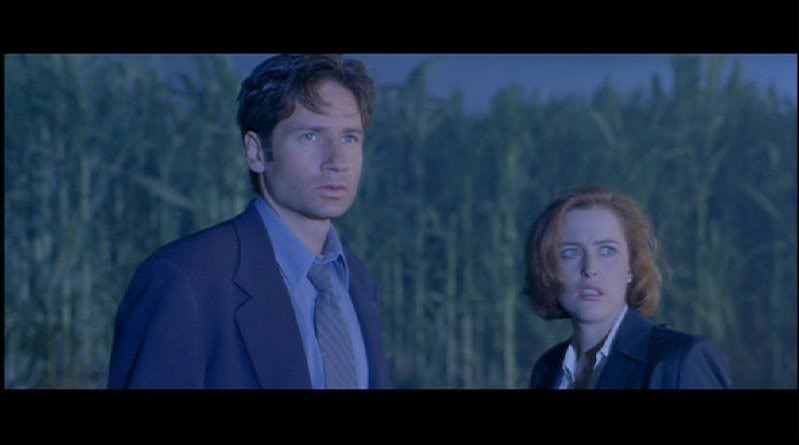
-- The idea of having Scully stop and fix her hair and clothing before going in to the OPR meeting was suggested by producer Daniel Sackhiem. "Scully's been up for three days, never having a chance to go home and primp," explained Chris Carter. "So she stops a moment and looks at her reflection in a photograph of a former FBI boss and primps herself for a second. It was a nice little touch of class."
-- Very convenient that Mulder just happened to have an old scrapbook that contained photos of the Consortium Family Picnic circa 1966.
-- "The theme that really comes out in the movie is that Mulder needs Scully," said Rob Bowman. "Never before has he come to that understanding quite so strongly as he does in this story, and he tells her so. In a scene filled with such virtue, with people sharing their highest thoughts and feelings towards each other, you come to a sort of pinnacle, respect and mutual admiration, that it leads to an intimate moment that neither one of them expect. Or were sort of working towards. It just sort of happens. So we came to the opportunity of a kiss for the first time, but it's not out of lust, it's not for any of the obvious or typical reasons. It's an emotional response to the overwhelming respect they have for one another, where you transcend logic and things become more visceral and human. The only place for him to go in my mind, to express his next thought, is to kiss her. But in typical X-Files fashion, you never give them anything they want, you just sort of lead them down the road and then say 'Auup! That's all you get.' So it stops just short of that zenith that the audience wanted."

-- "But we didn't want to completely cheat the audience," continued Bowman, "so later on Mulder gives Scully mouth-to-mouth resuscitation. So youíve got the intention of the kiss, and the physical act of them touching mouths and I believe in Chrisís mind, the idea was, you take those two, add them together and thatís a kiss! That counts! [Note: Bowman is certainly a pro at interpreting Carterspeak!] Sort of in the frustrating X-files fashion, thatís a kiss. I obviously thought that there was more gained for the audience out of a hallway kiss. And I donít think anyone but Chris really walked out thinking, well they sorta did if you add the two together. I know it wasn't the same for the fans, but the idea was they were going to, so as a story point, that counts as a kiss. It wasnít because they stopped themselves; something else entered the scene and interrupted them." (As if that's any consolation!!)
-- David Duchovny actually thought the "near-miss kiss" was the best choice. "The 'kiss' is really clever," he said, "and I like the scene a lot. I think it shows much more than just physical contact, which happens. I think it shows the desire, more than the actual consummation, which is always much better. Don't you think? No, actually it isn't. I think it's better in the movies. It's bad in life."
-- Regarding the outtake kiss from the movie, Duchovny said, "We were acting like it was a gross carnal coupling. You know, it was a joke for the crew and for us. The actual kissing, that was never a part of the movie, so we never would have shot that. No, the only time we did that was as a joke. Gillian and I did it to our liking, and then I said, 'Let's do one where we're up against the wall here.' We were outside of the camera's view, actually, at that point. So that's not even on film, I don't think." Of course, as we all recently discovered, the brief kiss was indeed captured on film and was included in the movie's gag reel.
-- In the scene where Scully collapses in Mulder's hallway due to that nasty bee, she just happens to lie down on honey-comb-patterned linoleum.
-- In keeping with the bee-theme, it is worth mentioning that Scully quit because she was going to be transferred to Salt Lake City, Utah; Utah is also known as the "Bee-Hive" State (the Bee-Hive being the symbol for industry on the state flag).
-- Oopsie! It's daylight through Mulder's window when he's looking at the photo album, but it's night when Scully is taken away in the ambulance.
To be continued ...